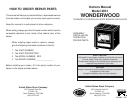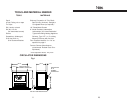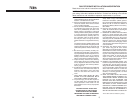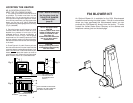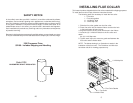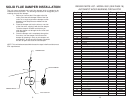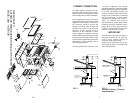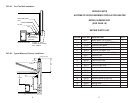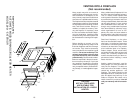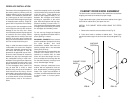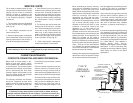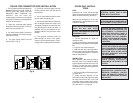
1.
2.
3.
4.
5.
6.
7.
8.
22 3
RULES FOR SAFE INSTALLATION AND OPERATION
Read these rules and the instructions carefully.
SAFETY NOTICE: If this heater is not properly installed, a house fire may result. For
your safety, follow the installation directions. Contact local building or fire officials
about restrictions and installation inspection requirements in your area.
Check local codes. The installation must
comply with their rulings. Do not install this
heater in a mobile home or trailer.
Always connect this heater to a chimney or
vent to the outside. Never vent to another
room or inside a building.
Do not connect a WOOD burning heater to
an aluminum Type B gas vent. This is not
safe and is prohibited by all codes. This
heater requires connection to approved
chimneys: Either a factory built 6" UL 103HT
or a lined, approved, recently inspected,
and cleaned masonry chimney with a 6"
flue, preferably round. A larger masonry
flue may be used, so long as the flue-
section diameter is not greater than 50 sq.
in.
The chimney portion (whether factory-built
or masonry) must be tall enough to provide
sufficient draft and safe exit of smoke and
combustion products. Please refer to Page
5.
Be sure that your Chimney is safely con-
structed and in good repair. Have the chim-
ney inspected by the Fire Department or a
qualified inspector (such as a Chimney
sweep). Your insurance company may be
able to recommend a qualified inspector.
Inspect chimney connector and chimney
twice monthly during the heating season
for any deposit of creosote or soot which
must be removed (see Chimney Mainte-
nance, page 14).
Provide air for combustion from outside the
house into the room where the heater is
located. If the intake is not in the same
room, air must have free access to the
room.
CAST IRON PARTS MUST BE "SEA-
SONED" TO AVOID CRACKING. BUILD
ONLY SMALL FIRES ON FIRST USE.
To prevent injury, do not allow anyone to
use this heater who is unfamiliar with the
correct operation of the heater. Do not
allow children to use or in any way operate
this heater.
For further information on using your heater
safely, obtain a copy of the National Fire
Protection Association (NFPA) publica-
tion "Using Coal and Wood Stoves Safely"
NFPA No. HS-10-1978. The address of
the NFPA is Battery March Park, Quincy,
MA. 02269.
Keep the ash pit section free of excess
ashes. Do not allow ashes to stack higher
than the sides of the ash pan.*
DISPOSAL OF ASHES- Ashes should be
placed in a metal container with a tight
fitting lid. Keep the closed container on a
non-combustible floor or on the ground,
well away from all combustible materials.
Keep the ashes in the closed container
until all cinders have thoroughly cooled.
The ashes may be buried in the ground or
used as fertilizer.
CAUTION: The special paints used on
your heater may give off some smoke
while they are curing during first few fires.
Build small fires at first. The metal used in
construction of the heater has a light coat-
ing of oil. This could give off smoke and/or
odors when heater is used for the first
couple of times. This should disappear
after a short period. Once this burn-off has
occurred, it should not reoccur.
CARING FOR PAINTED PARTS- This
heater has a painted outside jacket, which
is durable but will not stand rough han-
dling or abuse. When installing your heater,
use care in handling. Clean with soap and
warm water when heater is not hot. DO
NOT use any harsh chemicals (acids or
caustics) or scouring powder, as these
wear and dull the finish.
KEEP THE FEED DOOR, ASH DOOR
AND CABINET DOOR CLOSED AT ALL
TIMES EXCEPT WHILE TENDING THE
HEATER. DO NOT OVERFIRE THE
HEATER. THIS WILL HAPPEN IF THE
FEED DOOR, OR PARTICULARLY THE
ASH DOOR, IS LEFT OPEN DURING
OPERATION. UNDER EXTREME CON-
DITIONS THIS CAN PRODUCE DAN-
GEROUS RESULTS. AS A MINIMUM, IT
WILL ALLOW THE PAINT TO DISCOLOR.
*Never allow ashes to contact the grate(s).
CAUTION: DO NOT TOUCH THE
HEATER UNTIL IT HAS COOLED.
ALWAYS WEAR GLOVES WHEN
REFUELING THIS UNIT OR WORKING
WITH METAL CABINET PARTS.
9.
10.
11.
12.
13.
14.
Notes



